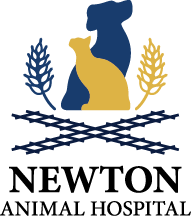Library
-
Some 50-80% of all cats over the age of four have periodontal disease (infection of the tissues surrounding the teeth). Brushing three times a week is the minimum recommendation to help remove plaque and prevent tartar accumulation. To be successful at brushing your cat's teeth, you must make it a positive experience for both of you. Do not use human toothpaste or baking soda. A list of dental products and diets that have been accepted by the Veterinary Oral Health Counsel can be found at vohc.org.
-
It is estimated that over 80% of dogs over the age of three have periodontal disease (infection of the tissues surrounding the teeth). Brushing three times a week is the minimum recommendation to help remove plaque and prevent tartar accumulation. To be successful at brushing your dog's teeth, you must make it a positive experience for both of you. Do not use human toothpaste or baking soda. A list of dental products and diets that have been accepted by the Veterinary Oral Health Counsel can be found on www.vohc.org.
-
A caesarean section is a major surgery to help deliver puppies, usually performed in an emergency. After surgery, the dog may be sleepy but should be able to eat a high-quality diet and nurse puppies within a few hours. The dog should be monitored for fever, abnormal vulvar discharge, and abnormalities at the incision.
-
Pet owners may not realize that caffeine can be harmful to their pets. They also may not know that many foods and drinks in their cupboards contain caffeine. This particular chemical can be toxic for both cats and dogs.
-
Canine influenza is a relatively new, highly contagious virus that causes respiratory disease in dogs. It has been reported in all US states and some Canadian provinces. Clinical signs include coughing, runny nose, and fever. Definitive testing can be performed in the early stages of the disease. Vaccination is recommended for dogs at a higher risk of infection or morbidity. The virus is not spread to humans, but cats can become infected.
-
Cats and dogs can become intoxicated by cannabis in various ways, most commonly by eating edibles (e.g., baked goods, candies, chocolate bars, and chips containing cannabis), or by ingesting cannabis directly (in any form). Pets can also be exposed to second-hand smoke. A small amount may affect one pet more than another, so there is no official safe level of exposure. Many of the signs of intoxication are neurological, including disorientation, dilated pupils, and hyperactivity. In severe cases, tremors, seizures, and coma can result. Regardless of the method of exposure, accurate and complete information from the owner is imperative to treat the patient successfully.
-
Chameleons are fascinating pets with bright colors and eyes that can rotate 360 degrees. Chameleons range in size from 0.9 inches to 27 inches long. They require special considerations in relation to their cage set-up and diet. Most chameleons do well on a cricket, mealworm, or waxworm-based diet. All chameleons require UVB lighting, a heated cage environment, and humidity of 60%-90%.
-
Vaccines save lives and prevent disease but can have some mild common side effects. Other less common but more serious side effects can occur within minutes to hours after vaccination. These reactions are considered medical emergencies, and you should seek veterinary care immediately if you suspect your pet is having a more serious reaction.
-
Sometimes, the location of your cat's wound or the amount of skin lost can prevent surgical closure or bandaging. This handout describes general guidelines for proper care of your cat's open wound at home; your veterinarian can provide you with specific instructions.
-
The average horse lives to be approximately 20 years of age, although many ponies and a few horses live for 30 years. Older horses and ponies need a little extra care to ensure that they remain healthy and happy.


